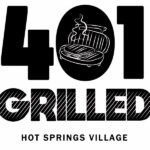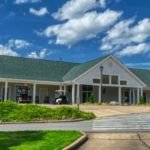by Tom Blakeman, March 14, 2020
Selected excerpts from The History of Hot Springs Village
If you have not seen and read this history of our Village you should. It is lengthy, some 441 pages, and is available in PDF format. It was written in 2000 and had limited updates through 2006. Given that this is our 50th Anniversary it is timely to take a look back.
There are ongoing comments on Nextdoor and other media continuing to blame CCI for all of our present-day issues. Many apparently think Cooper alone made all the decisions all along the way. There are many who think that our Board of Directors should only set policy and have no active role in administration. There is continuing debate about how/when the lot situation and their devaluing occurred. And, of course, there is constant commentary about our election integrity and the security and purpose of our gates.
These excerpts may clarify some things, may dispel some myths and correct some long-standing beliefs: [note that some color/emphasis/italics have been added for clarity]
1970: Only John A. Cooper employees and close business associates were available to serve on the POA Board until 1974. In December 1974, Article XII was amended to increase the number of Directors to seven (7).
1973: By the year 1973, all members selected to serve on Standing Committees were residents.
1974: At the September 18, 1974 meeting of the Board, the General Manager, Elwood Bell, stated: “that all private access roads had been blocked by cable.” The Board then adopted the resolution: “that all temporary provisional access to the Village be permanently closed without exception, and that all traffic entering or leaving the Village will be through authorized controlled access points.”
1975: In May 1975, the two policy-making bodies, CCI and POA, were independent of each other. Even though the two corporations (CCI and POA) were destined to function in close association, the Board of Directors of the POA, for the first time, was making the policies without direct influence of the CCI.
In 1975 the membership of the Board of Directors was changed from five to seven members and the terms of office from four and six years to three-year staggered terms. During the past 25 years, consideration has been given to increasing the number of Board members to nine, but action never occurred; therefore, the number of members of the Board and terms of office has remained unchanged for 25 years.
Vernon Smith: President, 1975-1976 – The first president who was elected to the Board of Directors by the Membership and elected president of the Association by the Board of Directors.
Alan (Al) Klein: General Manager, 1976-1994 – Al Klein was the first General Manager to be employed by a Board of Directors elected by the membership.
Robert (Bob) Reik: Director of Finance and Treasurer, 1977-1991 – Bob Reik was the first Director of Finance and Treasurer to be employed by a Board of Directors elected by the membership. Previous Treasurers were Thomas Dees, 1970-1974, and William Putman, 1974 to 1977.
POLICY AND MANAGEMENT – During the first four years, particularly 1970 through 1973, the Hot Springs Village Board of Directors developed policies, made most major management decisions, developed procedures, and provided leadership of the Association.
A study of the minutes of the Board of Directors indicates that the Board functioned in large part as both policymakers and administrators. The administrative role of the Board was evident in the governance of the Village for more than 20 years, although its role in administration was attenuated as years passed. In the middle nineties to 2000, the Board of Directors deliberately and aggressively took steps to move totally away from administrative functions and to focus only on policymaking.
2002: Economic and Fiscal Impact Study – The HSV BOD approved a proposal from Wayne Miller of the University of Arkansas at Little Rock to perform an updated Economic and Fiscal Impact Study of Hot Springs Village for $10,000, of which the POA would support a maximum of $5,000.
2003: National Recreational Properties Inc. – The Hot Springs Village Board of Directors entered into an agreement with National Recreational Properties Inc. of Irvine, California for the sale of foreclosed lots in the POA’ s inventory. NRPI purchased all lots in the POA inventory for $500 each, which includes one year’s worth of assessment payments. After the initial purchase, NRPI will continue to purchase a minimum of 50 lots per month, if available, for $500 each for the first five years of the contract and $1,000 each for the last five years of the contract. NRPI opened its local operations at the East Gate in the vacated Cooper Land Development offices.
2006: Election of Board Members – Ballots were numbered to prevent tampering and were returned to an independent auditing firm for counting. Election Day Committee was abolished.
These foregoing excerpts are only a sampling of the extensive information in the History. Property owners, particularly those who are now or will be our leaders, are encouraged to take some time and read the full text (below). After all, if you don’t know where we have been how can you chart the course of our future?
History-of-HSV-from-Tom-Blakeman











Dan
03/14/2020 — 4:20 pm
Follow the money from 1970 to 2006, then follow the money from 2006 to present ,see if there is a difference in the upkeep of HSVD
Minn Daly
03/14/2020 — 6:43 pm
Tom, thank you for HSV history. Prior to 2006 we had a BOD that cared for this community. After 2006 we have had BOD members that hired the likes of Scott Randall, Twiggs & Nalley. They changed the management titles, changed HSV POA staff titles, tried to make HSV into a status symbol of eletist that no one needed or wanted. We were as owner members complacent & not attending BOD meeting, not watching who we elected & certainly not paying attention to finances or the committees they put into action. We elected board members who only wanted status symbols & not what the majority of community owners wanted. Now we have a chance to take our community back with LTD. we need to help them get our community back on track! Get our by-laws back get rid of CMP, Governance & all other committees that are not in line with building Our community. We as owner members need to be vigilant & supportive of LTD because they have inherited a mess. Minn Daly
Moe
03/14/2020 — 7:31 pm
Complacency killed the cat.
Sarah
03/15/2020 — 5:43 am
HSV is not, nor will it ever be, a place for the New Urbanism fools to try an experiment. This history proves that. Wrong place. Wrong time. Wrong people.
How hard is it for people to figure this out??? It is not rocket science. It is common sense.
We are broke, the infrastructure is decaying faster than it is being maintained, the average age of residents is quite high, we have no way to “connect” anything, we don’t even have adequate Internet connectivity. We are in a rural setting in a state that is not New Urban friendly. And never will be.
So, my friends, give up the dream of the lodge, the pocket neighborhoods, the high density, low income housing, the town centers, the new grocery store, and all the other rubbish in the phony boilerplate document they refer to as the “CMP”.
There is nothing comprehensive about it. And it is not a “master” plan for anything other than an even more rapid decay of HSV. It would not be possible to waste $500,000 more thoroughly than this idiotic purchase. Total and absolute waste of OUR money. Never to be recovered. And never to be implemented.
The only saving grace to any of this is the sheer and unmitigated incompetence of the little “ceo” and the “board” assure that the “CMP” will never be implemented in any fashion. They can not do it. Ever. They can’t even run an election. Out of their league has a whole new meaning with these folks. Hard to imagine a more bumbling, inept, ill-prepared, out of touch group anywhere. It is A Saturday Night Live sketch every day with these people. Sheer madness.
Stop the insanity. Stop it now.
Vote LTD if you can.
Linda Anderson
03/15/2020 — 12:07 pm
TOM, Thank You. History shows grave mistakes of leadership that have impacted the future of our great village which could have been prevented by responsible and reasonable decisions. A huge Board mistake was to give the Title of ” CEO ” to Nalley with an absurd salary. Most Corporate CEO’s make their huge salaries based on stock prices. It’s all about making the stock prices go higher. A WALL STREET ” CEO ” mentality. This should have never been compared to the management of 15,000 residents and proper maintenance of properties. The last 3 Board’s lost their sense of reality. They listened to the spin of CMP development fantasies with reckless spending. They have ignored maintenance and the effects of crumbling roads, buildings and golf courses. HSV’s financial future is at risk. CHANGE IS DESPERATELY NEEDED NOW.
VOTE-LTD.
Anonymous
03/15/2020 — 12:10 pm
To blame recent Boards and POA managements for the financial mess we are in today seems short-sighted to me. it is obvious from reading this history that the Coopers did not use an honest appraisal of what would be required of those purchasing in their new development. It was clear immediately that to only charge the new owners $12.00 per month and expect them to participate in the development costs of the Village was foolish. Obviously, their intent was to keep the monthly costs down to use as an incentive to buy and then load them up with debt to help in the development. Having purchased new homes in several new developments, this is not the way honorable developers operate.
Sarah
03/15/2020 — 2:05 pm
Who else is supposed to be a participant of the development costs of the place if not the new homeowners?
To blame Cooper is not only shortsighted, but meaningless. Have you developed anything more successful? Inquiring minds want to know.
Who cares what happened decades ago???
No wonder you signed anonymous….
The only foolish is you!!
Kirk Denger
03/16/2020 — 8:16 pm
CCI is honorable, Anonymous 03/15/2020 — 12:10 pm is not.
Anonnymous
03/15/2020 — 2:21 pm
Every developer I’ve known has paid the development costs and passed it on to the people as they’ve bought in. To expect people to keep paying his costs for properties after they’ve already bought in is crazy. That’s only a way for the developer to pay very little of his costs. When you buy into a development, you should be expected to pay your share of the development costs when you buy in. You are right. We should look forward. Stop blaming people who are only trying to figure out a way out of the mess we are in. This Village was developed with a plan that greatly benefited the developer and has hurt the people buying into it.
Tom Blakeman
03/16/2020 — 10:33 am
All developers “paid the development costs and passed it on to the people as they’ve bought in”. That’s just how development works. Always. All development plans “greatly benefited the developer.” It wouldn’t work any other way.
The problem which has been created here, as I see it, is threefold:
1. The owners, led by a POA run by themselves (not the developer) for 45 of the 50 years, not only allowed over development of certain facilities (such as golf courses), they gladly participated in it. Meanwhile, maintenance (the principal responsibility of the POA) was largely ignored.
2. The same owners, led by a POA run by themselves for 45 of the 50 years, decided about half way along, to step back from day to day management of the place and let the hired help take over. A feel good ‘policy’ decision. More time to play golf, I guess.
3. Then, about 40 years into the process, after making a series of other poor ‘policy’ decisions, such as allowing lot owners to ‘walk’ and then basically giving away the ‘repo’ lots, a few woke up and decided to double down on the hired help idea and “corporatize” the place. Guess what? That didn’t work either.
So, Anonnymous is right: “Stop blaming people who are only trying to figure out a way out of the mess we are in.”
We now have three candidates (LTD) and one board member (DP) who want to roll up their sleeves, take back control and get back to basics. They want to undo all the lousy ‘policy’ decisions of the past and make the hands on hard decisions to save our collective asses.
I say let them do it.